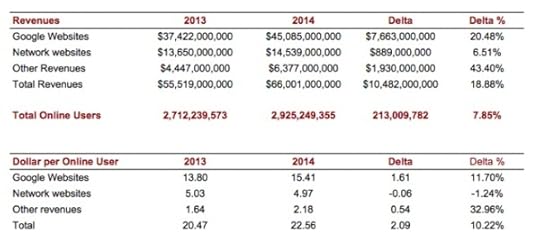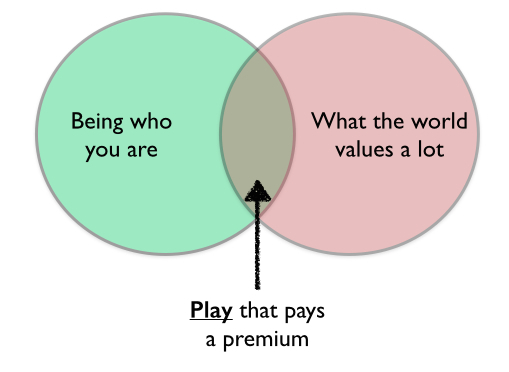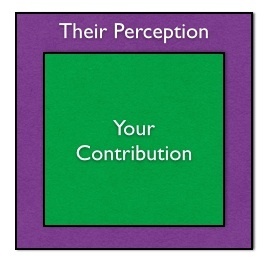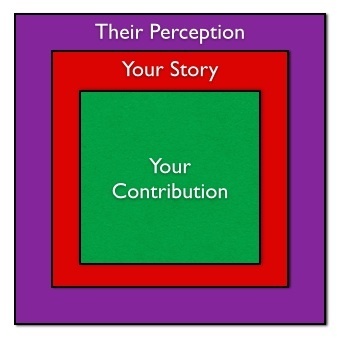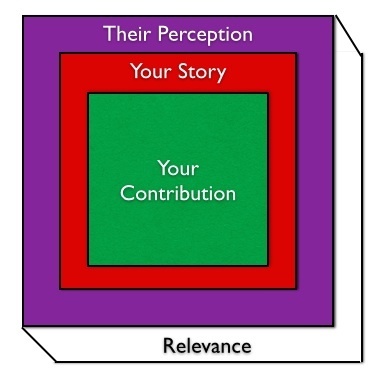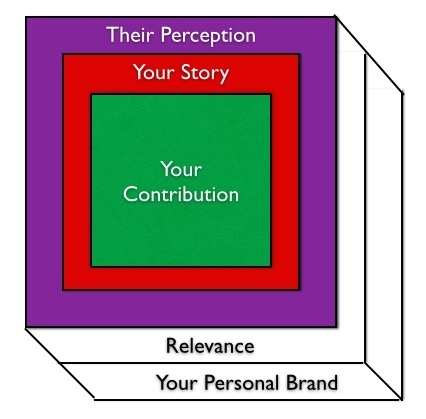Rajesh Setty's Blog
April 26, 2015
The Collective Forces Against Google’s Dominance
Google’s dominance today is unquestionable. The word Google has become a verb.
But, that has not stopped several dominant forces to work against it. Interestingly, there is no one challenger that has emerged to fight against it, however, a collective set of forces are coming at Google all at the same time.
Key Observations About the Revenue Engine for Google
it is no secret that the revenue engine for google is advertising. It has been that way for a LONG time, but now it’s slowly shifting to “Other Sources”
I took a basic set of numbers from the last two years from public filings AND publicly available information about the growing number of online users.
Here is the chart for your quick reference:
Here are quick observations with reference to 2014:
1. The Gorilla of the revenue sources continues to be Ad revenues from Google Websites growing at 20.48% from year 2013
2. The slowest growth rate (6.51%) is the revenue from Network sites
3. The highest growth rate (43.4%) is from “Other Sources”
4. Online users at the end of 2014 stand at 2,925.249,355 and has grown 7.85% from 2013
5. Dollar per online users grew by 11.7% for Google websites but dropped by 1.24% for the network sites. Interestingly, the dollar per online user grew by 32.96% for “Other Sources.”
6. Overall the growth of dollar per online users was around 10%
If we remove the “Other Sources” from the picture for a while Y-O-Y growth does not look as good as it could be.
The various reasons for that is the focus of this article.
The Problem With the Key Driver of Revenues: Intent Expression Engine
Think about it. If the ad revenues from Google websites (mainly Google Search) continues to be the dominant force, there must be something magical about it. Well, it is magical, but it’s also common sense now. The magic happens to be that, today, Google still happens to be the place where people express their intent. It is the ultimate “intent expression engine,” Advertisers love it because they can creatively intercept the users at the point of intent expression and get them to their various offers.
In fact, this is so good that various advertisers continue to bid against each other on how much more they are willing to pay Google to get ahead of others to make this interception.
It seems to work as a WIN-win-win. The big WIN is for Google as advertisers fight to pay more than others to get in front of the line. The consumer and the advertiser win too in this game.
So, what’s the problem?
The key issue is that less people are using Google to express their intent. The alternative options available to express the intent and those are the collective forces acting against Google’s Dominance.
The Collective Forces
Here are the various forces (not a complete list by any means)
1. Social Networks
There are many globally, but for discussion purposes, I picked a few:
The Facebook Family (Facebook and WhatsApp to start with) is taking the lions share where people express their intent (apart from sharing other stuff, of course)
I have seen people posting questions and receiving responses almost instantly on Twitter.
LinkedIn discussion groups are filled with people asking and getting answers for their questions.
Quora is a human-powered Q&A engine focused on trivial to deep questions.
People have only 24 hours in a day. Time spent elsewhere is time NOT spent on Google properties.
2. Internal Knowledge Networks
Rise of amazing tools like Slack or Salesforce Chatter instantly gives you access to the internal or group knowledge networks. Rather than going to Google, one can simply post the question (intent to know) on the network and receive more thoughtful answers from members of their tribe.
3. Specialty apps
Specialty apps are taking a share of the intent expression engine in a big way as parametric searches are superbly build-in within the app interface. Here are some examples:
Yummly is an interesting recipe aggregator if you are looking for recipes
Spring is a shopping app that customizes what you see when you shop
120 Sports will give you access to expert commentary on trending sports topics
Yelp lets you find and see reviews of restaurants wherever you are
I can go on and on…
Every time someone expresses their “intent” on one of the apps, that is one search less for Google.
4. Learning Destinations
In this fast moving world, people have to learn at a rapid pace just to stay in the game. Curated knowledge of any kind is pure gold.
Learning portals like Khan Academy, Udemy, Lynda.com (now part of LinkedIn) is taking away a ton of traffic where people express their learning intent and once they find something they need, they spend a lot more time consuming that curated content.
Our own startup, Audvisor has an “eyes free, hands free” approach to curated content from invited experts. It’s like “Pandora for expert advice,” helping you probably make the most of time that was previously not fully leveraged (commuting, workouts, waiting, dressing up etc.) to learn and grow. In this case, if you express your intent as “Help me advance my career,” all you have to do is to push a button, lean back and learn from worldwide set of experts.
5. Radical Innovations
Radical innovations like Amazon Echo aim to intercept the intent of the users even before they reach for a computer. They are home or office companions that are available at your beck and call, answering questions from you or anyone around you bypassing the need to go to Google.
Final Comments
What is impressive about Google is that it continues to maintain its dominance in spite of all the collective forces working against it. Hats off to them. Now, time to wait and see how this all plays out.
PS: Two more articles you might be interested in are below
1. What to do When Your Core is Growing Fast, but NOT Fast Enough (About LinkedIn)
2. The $17K Watch and the Art of Deflection (About Apple)







February 18, 2015
Mini Saga #136 – Preconception
Mini Saga #135 – Preconception
Mark was shocked and amused when his three-year old son screamed, “Dad, I suck.”
“What?” he asked.
“I suck, Dad, I suck” the boy repeated.
“Where did you learn that?” Mark asked
“Don’t know, Dad. I suck and can’t get out, “ the boy said.
“Oh, you’re stuck..” smiled Mark.
Sometimes, our preconceptions take over. They can lead to humorous situations like the above or they can lead to misjudgments that can have a negative impact on our life, career or business.
Thanks to Marcus Nelson for allowing me to share his experience in the form of a mini saga.
Photo credit: Alicia Piper on Flickr
Note:
1. A mini saga is a story told in exactly 50 words. Not 49 or 51 but exactly 50.
2. You can download a photographic manifesto of Mini Sagas at ChangeThis. Here is the link – Mini Sagas: Bite-sized Wisdom for Life and Business (PDF, 2.9MB).






January 25, 2015
Mini Saga #135 – Leave Your Mind
Mini Saga #135 – Leave Your Mind
The temple door said, “Leave your mind and shoes at the door.” Nodding his head, Ravi walked in. An elderly man stopped him, “Sir, can’t wear your shoes inside.” Ravi said, “Ah..sorry, when I left my mind, I forgot about shoes completely.” They changed the sign reordering the instructions.
Sometimes, the order makes a big difference…
Note:
1. A mini saga is a story told in exactly 50 words. Not 49 or 51 but exactly 50.
2. You can download a photographic manifesto of Mini Sagas at ChangeThis. Here is the link – Mini Sagas: Bite-sized Wisdom for Life and Business (PDF, 2.9MB).






December 16, 2014
Lessons from The Instigator Experience – Interview with Srinivas Rao
I have known Srini for a number of years and he never ceases to amaze me with his interviews (The Unmistakable Creative series) and the projects that he pursues such as The Instigator Experience events.
Being a co-host of a few Cerebrate events in the past, I am fascinated with the concept of The Instigator Experience. I asked Srini a few questions about the lessons learned from creating and hosting the last event. Here is that interview:
RS: Srini, what is the Instigator Experience and more importantly what led you to create this event series?
SR: It’s a 2 day bushiness event for people want to create or change something meaningful in the world (i.e. start a movement). It was actually born out of my frustration with many of the events that I went to.
First I thought nearly every conference I went to was too big. I walked with away with stacks of business cards but no real connections. I realized by creating an intimate environment it would result in a deeper more lasting connection between people. That’s why we decided on application only, 60 person event.
Second, the format of the events I went to drove me crazy. They were held in typical venues like hotels and convention centers. People spend all day sitting in chairs and listening to speakers give powerpoint presentations. When I spoke with a graffiti artist named Erik Wahl he said “live music has engaged participants, keynote speaking has passive consumers. There’s room to be explore in how you bridge that gap.” I thought it would make sense to approach an entire event that way. When we were recently speaking with a venue manager, I said “well if TED met Cirque De Soleil, you’d have The Instigator Experience.”
In many ways you could say that I created the conference I wanted to go to.
RS: What were two big challenges in organizing the event and how did you overcome them?
SR: The first one is always staying within budget. The costs of putting on an event add up really fast. So you have to watch every line item closely. The way to overcome this one is to hire a great event manager and of course have a strong understanding of what it costs to put on the event you want to create.
The second is content. Most people throw a bunch of speakers in a room. Then they try to make order out of anarchy. But we work really hard to make sure there’s a logical flow and thought process behind every speaker we select. We start with the outcome we want for our attendees and then build our speaker selection and event flow around that.
RS: What were the key takeaways for attendees from the last Instigator Experience?
SR: Of course, this actually differs from person to person. But perhaps the most important takeaways of all were that
1. Our temporary circumstances don’t have to become our permanent reality and
2. We live in a made up world. Everything around us was nothing but a thought in someones’s head.
I have to give credit where credit is due for that. My mentor Greg Hartle has taught me that. And in terms of specifics many of our attendees from last year have quit their jobs, grown their businesses, written books and much more.
RS: What were the surprises, if any
SR: Perhaps the biggest surprise was just how impactful the event was on the lives of people who attended. Last year, we were playing with a completely unproven idea that nobody had ever done before. So I guess you could say that it worked as well as it did was really amazing.
RS: What should one do next if they want to attend one?
SR: Glad you asked. The next Instigator Experience event is happening on April 23-25, 2015. As you can imagine, this is a highly curated event both for speakers and attendees. We have finalized a stellar set of speakers. One can submit an application to attend at http://www.theinstigatorexperience.com






December 14, 2014
One blind spot to avoid in your quest to be true to yourself
You would have heard (generally from motivational speakers) about the need to be true to yourself. Common terms used are:
Be yourself
Be true to yourself
You can only be yourself, everybody else is taken
Be You
I can go on and also I agree with most of the statements but with a caveat. If you want to feel good about yourself and exercise freedom of speech or freedom of expression then go ahead by all means. Nobody can stop you.
But…
If you are thinking of meaningful accomplishments, the above theory paints only half the picture. There is a blind spot to avoid with the above approach and if you don’t take care to notice it, you will be happy with yourself but may not make a lot of progress.
Let me explain.
The rebel in you
The rebel streak is in all of us. It is in me. It is in you. Sometimes you may get carried away and start taking actions just because you can! Examples include tattoos anywhere and everywhere, punk hairstyle, wearing clothes that literally makes no sense etc.
If anyone asks you, you can try to get away by seeing you are true to being yourself.
The blind spot
In your quest to being true to yourself, you can forget about the marketplace you are operating in. The marketplace operates on a simple principle – exchange of value. You bring value to the marketplace and you get back value – typically in the form of cash. You bring more value in the marketplace (and market it right) the marketplace will bring more value back into your life.
The marketplace does not care about whether you are being true to yourself. It is busy transacting for value with all the players.
There is an exception to the rule which I will cover a bit later.
Finding your element
The magic is actually in the intersection of “being who are” and “what the marketplace values a lot.” When you find that element, life is truly magical.
When you are being yourself, the effort is at a minimum because you are just being YOU. At one level it becomes “play” for you. Something that’s fun.
When being YOU is creating value in the marketplace, that intersection becomes a “play that pays a premium.”
It’s play for you; huge value for them.
What more can you ask for?
The place for other kinds of uniqueness
As I signaled earlier, there is a place for other kinds of uniqueness and that comes after you are well known for meaningful contributions in a particular field.
For example:
You are a world famous guitar player and you fancy crazy tattoos on your forearms. It becomes interesting.
You are one of the best negotiators in the world and you have punk hairstyle. It becomes interesting again.
You are a serial entrepreneur that has taken a couple of companies to IPO and you have your tongue pierced. It becomes very interesting.
The quirks were not necessary, but they sure become “interesting” points of discussion and draw attention.
You can’t try to reverse the story and go for the quirks before you create value in the marketplace. The sequence in this case is VERY important.






December 7, 2014
Why is it hard to get what you are worth?
You or someone you know are struggling to see how to fill the gap. The gap I am refering to is the difference between what you earn currently and what you are worth. There is an outside chance that you are in a situation for personal reasons where you can’t positively influence how much ever you try to reduce the gap. I say it’s an outside chance because those situations are rare. It does feel good to say that you are in one of them because when you truly believe that, “you absolve yourself from the blame” for your current situation. You are a victim and you are in a way happy being one because it provides a clean license for inaction.
There is another (more probable) reason for having a big gap. That is your mindset about how you earn what you are worth. It is a “humble” mindset where you expect your work should speak for itself.
The stakeholders around you should form their perception based on your contribution. Higher your contribution, better should be their perception about you.
The Missing Element
With the above mindset, there is a problem. The problem is that the stakeholders have to tell a story about your contribution (more work for them) that will shape their perception about you. Plus, when you let the stakeholders create a story, you don’t have control on what stories they will create and hence you don’t have control about how their perceptions are formed about you.
When you take responsibility to add the missing element and learn to tell better stories about your contribution, you remove one of the variables (story variable) and more importantly influence the other variable (perception variable)
So, whether you want or not, learn the art of storytelling as it is fundamental to shape the perceptions.
Two More Elements
Apart from the stories you tell about your contributions, there are two more foundational elements that will influence the stories you tell and the perceptions they form.
Here they are:
1. Relevance
None of your contributions are in a vacuum. They all fall under some context. If they are “highly relevant” to the stakeholders, the stories get highlighted quickly and if they are not, it rarely matters how good your contributions are, your stories will simply create noise.
2. Your Personal Brand
Your personal brand is hugely influenced by your previous highly-relevant accomplishments. It is the “lens” through which your stakeholders view your current contributions and hence the stories you tell about them. History is your good friend if you have been making meaningful contributions in the past. If you have not made a lot of meaningful contributions, your history can become your biggest enemy.
There are more variables in play but the above three are good places to start taking some responsibility to reduce the unpleasant gap that you or someone you know are experiencing.
All the best!






November 29, 2014
How to Handle Thankless Assignments
A thankless assignment is one where there is a limited upside for doing a great job on the assignment, but there is a serious downside if something goes wrong with it.
You (or someone you know) have been tasked with thankless assignments not once, but many times over unless you have been “Vegas-style lucky” – meaning VERY VERY lucky..
Over the last few years, I have helped a number of people handle thankless assignments and turn them into situations that will create potential advantages for them. Here I present those ideas that have worked well.
Here we go:
1. Understand AND track the big picture in real time
A thankless assignment is generally a piece of the big puzzle. If you don’t understand what the big picture looks like, you will be at a serious disadvantage. Why? Because the big picture keeps changing based on market conditions and for good or bad you may not be informed of all the changes even when it means that your assignment when completed will look like a square peg in a round hole. It is your responsibility to ensure that your assignment is tracking the big picture ALL the time.
2. Get visibility to your assignment
However big or small your assignment is, it is also your responsibility to get visibility to your part of the overall puzzle. Nobody is going to do that for you because if they did, it would not be called a thankless assignment. The more visibility you have, the lesser the chances that your efforts will be swept under the rug when the overall project succeeds.
3. Raise a silent alarm if anything else hurts completing your assignment
Your thankless assignment is rarely executed in a vacuum and there are dependencies on both sides. Your task i dependent on one or more people completing their tasks and there are others depending on your task to be completed for them to complete their assignments. The better you understand these dependencies better you will be. More importantly, ensure that you raise an early alarm if any dependencies on either side will affect your job to completed well. This will act as insurance policies should the overall project be affected for reasons that were beyond your control.
Honestly, I wish that you will never have to engage in thankless assignments. But, this is life. Whether you want or not, you will be faced with one or more of them. I hope the above ideas will help you turn them into advantages.






November 23, 2014
What is a real missed opportunity?
One of my favorite quotes is actually an African proverb. It goes like this:
When you want to go fast, go alone.
When you want to go far, go together.
It’s easy to understand and equally easy to forget, unfortunately.
With that in the background, let’s get to answering the question we started with: What is a real missed opportunity?
In short, the “real missed opportunity” is your inability to proactively help people in your network to accelerate the pursuit of their dreams.
Let me explain…
Let’s take an example of John. He is a member of your network and someone you have known for a while. John is young and on a fast track, but he is far from having the power to help you back in a meaningful way – at least not right now. In your conversations with John, he has shared what he is working on, the dream he is pursuing. It’s not a secret to you.
Let’s now focus on the very next step that John can take that will indicate very clear progress in the pursuit of his dream. The next step requires some additional capacity for John. This additional capacity can be something like knowledge, network, connections, out of the box thinking, brainstorming partnership etc.
There are many ways for John to get that additional capacity. YOU are one of those paths.
You are unfortunately busy. Why? Because you are pursuing your own dreams and you lack capacity to get to the next stage in those pursuits. Most of your time is spent courting those that have more power than you in the hope that they will lend that capacity to get you to the next stage. Those advances are sometimes thankless jobs because, like you there are a dozen other people who are courting the same powerful people hoping for things similar to what you are hoping for.
This creates two different scenarios on both ends of you.
1. You are courting more powerful people who have the power and money to buy additional capacity if there is a need. [Note: I am not saying that this part is not important. I am raising the awareness that this is happening so much that it may be making you ignore the second part below]
2. On the other end, there are people in your network who are starting out and need additional capacity almost as a favor now because they lack the power and money to be able to buy that additional capacity.
What complicates the matter is that people like John know how busy you are pursuing your own dreams so they rarely make an open request for help because they don’t want to be a burden in your life. For the same reason, you asking “How can I help you?” won’t cut it because John still does not know what is an acceptable ask and what is not.
The best way to help John would be to proactively lend some capacity in your area of strength to help him move the needle and push him towards that next milestone in pursuit of his dreams. By adding that capacity in your area of strength, it costs you less but it is still valuable to John.
If you choose not to help this way, John might not have it easy as he pursues alternate paths to get to the next milestone. You can be a bystander and watch that happen while knowing that you COULD have helped but you chose not to.
Why is this a “real” missed opportunity?
For multiple reasons – but most importantly for the following three reasons beyond the moral and ethical “right thing to do” reasons:
1. You build your future power base by lending your power and capacity to this that need it most. It is good to help those that are already in power in the hope that you will get into their good books but honestly they don’t have as much as need for you as someone like John who is just getting his feet wet.
2. You grow your strengths by putting your strengths to work where it matters most. This is not a fictional case study where you are “thinking” your way out. John is real and his needs are real. If you can move the needle using your strengths, you are getting better at using your strengths. Keep doing this and over a period of time you will move towards mastery in those areas.
3. This may be leaning towards a bit of spirituality but I will share it anyway because at least in my life and in the lives of many that I have personally witnessed, I know that “the more you give, the more the universe will bring back.” You get what you give out. This part is hard to prove but easy to experience once you put your faith in the process and go with the flow.
Now, over to you to think and reflect on any “real” missed opportunities in your own life…







July 13, 2014
Three Things to Think About Before Making a Request for an Introduction
First, let us clear a myth
It may be true that you may have only six degrees of separation from anyone else in the world. So, theoretically speaking, if you wanted to reach ANYONE all you had to do was to find the right six-degree chain and voila, you will be right in front of that person.
That rarely happens and for most part, will remain as a myth.
LinkedIn has made it easy to break the boundaries a bit. For starters, you can definitely see who is in your extended network. Again, mostly the power ends right there. Just because you can now see who is connected to whom does not make you entitled to be connected to them.
A new relationship, a new connection needs to be earned. That need for investment has not changed.
So, before you ask for the next introduction to someone you want to meet, think about these three things. To make it easy, let’s assume that you are asking your friend John to introduce you to Bob.
1. Trust:
Trust is at different levels. First, John should have enough trust to introduce you to anyone. That is like an entry ticket to the show.
You might have experienced this in your own life. Someone reaches out to you on LinkedIn, you look at their profile. Everything seems good so you accept the connection request thinking you will build a relationship. In the next ten minutes, the person sends you a request to introduce them to someone in your network. You are stumped and shake your head
The stronger your relationship with John, higher the level of trust on you.
The second level of trust in your competence in the context of what is being discussed. John should trust that you have the knowledge and skills on the topics in question.
You might have experienced this as well. Your trust your childhood friend on a ton of things but may be not as an entrepreneur because you believe that he is yet to prove himself. You get an email from him asking for an introduction to your friend who is a big name in the Venture world. You are now in a dilemma.
The third level of trust is in the project in question. John should strongly believe that your project has merit. It is also your responsibility to sell the concept of this project to John first.
2. Timing:
As in many things in life, timing becomes very important when it comes to requesting introductions.
Your project is super important and you KNOW in your heart that as soon as John brings this to Bob’s attention, Bob will be delighted and will meet with you immediately.
That’s all in your mind.
You don’t know Bob and what is going on in his life. Among all the available opportunities that Bob could pursue, you can’t tell where your project stacks up in importance. Because of the research you have done online and offline, you can make a guess but everything stops there. Your friend John can shed some light on this if John and Bob share a bond strong enough for John to get some additional insight.
The thing about timing that gets tricky is the element of luck involved in this. You can’t control this factor but one cannot dismiss the existence of that factor.
One thing you can do about timing is based on an old adage – “you must dig your well before you are thirsty.” In this context, it means that you MUST build the relationships way before you may need them. This leads to the next item – thoughtfulness.
3. Thoughtfulness
Thoughtfulness is about showing REAL concern for the needs and feelings of other people.
This goes to crafting of the request itself. Rather than thinking what’s in it for you, you will start thinking about what is the mutual benefit that you and Bob will derive as you start a dialogue. In fact, how can Bob win BIG with your proposal?
As you start thinking about this, you have to REMEMBER that Bob has many options to invest his time, energy and mindshare and your project happens to be ONE of them.
There is no simple litmus test for thoughtfulness. It is your job to keep working on crafting the request until you are very sure that it’s a no-brainer for Bob. It should be a request that John would feel proud to present to Bob. If the request is such that John considers this as an opportunity because HE happens to be the one presenting it to Bob, then you have won BIG.
Note: When I am talking about crafting the request, I am not referring to the narrative part of the request. A good narrative is necessary but not sufficient. At the foundation of the request is an opportunity and that opportunity is what needs to be carefully crafted to make it meaningful to John and Bob both.
Hope this helps.
Lastly, if you can read about my own journey of how I learned to make 300+ introductions per year here.







April 4, 2014
Mini Saga #134 – In a Fix
Mini Saga #134 – In a Fix
Jenny almost knocked off Rich as she rushed out of YMCA. She was on the phone, “Hey, sorry for the delay. I was with a client.” As Rich recovered, he found Jenny rushing back inside. She was still on the phone, “Oh you are going to YMCA…let’s talk later then.”
Sometimes you are in a fix because you chose to be in one of them…
Note:
1. A mini saga is a story told in exactly 50 words. Not 49 or 51 but exactly 50.
2. You can download a photographic manifesto of Mini Sagas at ChangeThis. Here is the link – Mini Sagas: Bite-sized Wisdom for Life and Business (PDF, 2.9MB).
3. For a complete list of Mini Sagas, please see the entire list here or at Squidoo
Rajesh Setty's Blog
- Rajesh Setty's profile
- 6 followers


